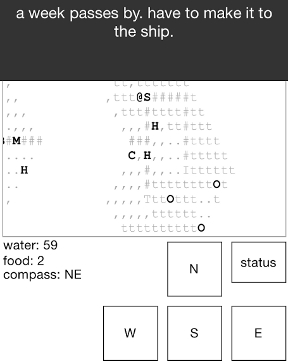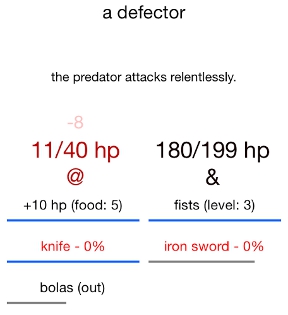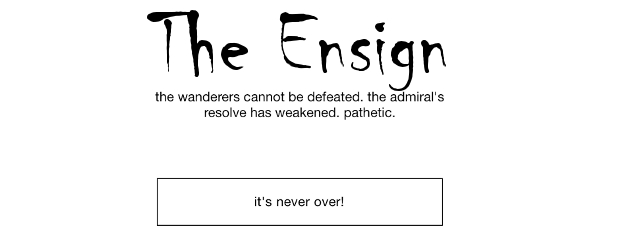![]() Doublespeak Games' A Dark Room was a smash-hit for a lot of good reasons, being an amazingly deep and epic simulation that revealed itself a bit at a time to patient players, and even eventually got a mobile port from Amirali Rajan. So when fans like myself are surprised by an iOS prequel like The Ensign, the reaction is, predictably, ohmygosh ohmygosh ohmygosh, but also hmmmm, because unlike the original game, The Ensign is actually a roguelike adventure. When your commanding officer gives up, you refuse to, and with only a few sups of water and scraps of food you set out into a hostile world to try to find and activate your ship. All you can do is follow your compass. The catch is that when you die, and you will die, a time paradox occurs and sends you back to the start of the game. At first it may appear like you're just beating your head against a brick wall, but as you try and try again, you'll begin to notice subtle changes in yourself and the world around you, though the world map will be randomized...
Doublespeak Games' A Dark Room was a smash-hit for a lot of good reasons, being an amazingly deep and epic simulation that revealed itself a bit at a time to patient players, and even eventually got a mobile port from Amirali Rajan. So when fans like myself are surprised by an iOS prequel like The Ensign, the reaction is, predictably, ohmygosh ohmygosh ohmygosh, but also hmmmm, because unlike the original game, The Ensign is actually a roguelike adventure. When your commanding officer gives up, you refuse to, and with only a few sups of water and scraps of food you set out into a hostile world to try to find and activate your ship. All you can do is follow your compass. The catch is that when you die, and you will die, a time paradox occurs and sends you back to the start of the game. At first it may appear like you're just beating your head against a brick wall, but as you try and try again, you'll begin to notice subtle changes in yourself and the world around you, though the world map will be randomized...
 The Ensign is entirely text-based, and even the game field is represented with numbers and letters, with bolded icons being places you can interact with. Don't worry that you don't know what any of these letters and numbers are actually supposed to represent in the beginning... like any good roguelike, The Ensign is about learning the game's rules as you play, and you'll get the hang of things quickly. Just tap the screen to make choices, and on the world map screen tap the compass directions to move around. Every step you take depletes your water by one, and your food goes down with every other step, and if either of those run out, you'll die. As such, managing your food and water is extremely important, and even challenging since food counts towards your maximum weight limit, and you'll need to learn how to replenish both... don't worry, you'll eventually be able to carry more of each. You can also die from combat, too, which can happen randomly as you explore both the world map and in places like caves, towns, houses, and so forth.
The Ensign is entirely text-based, and even the game field is represented with numbers and letters, with bolded icons being places you can interact with. Don't worry that you don't know what any of these letters and numbers are actually supposed to represent in the beginning... like any good roguelike, The Ensign is about learning the game's rules as you play, and you'll get the hang of things quickly. Just tap the screen to make choices, and on the world map screen tap the compass directions to move around. Every step you take depletes your water by one, and your food goes down with every other step, and if either of those run out, you'll die. As such, managing your food and water is extremely important, and even challenging since food counts towards your maximum weight limit, and you'll need to learn how to replenish both... don't worry, you'll eventually be able to carry more of each. You can also die from combat, too, which can happen randomly as you explore both the world map and in places like caves, towns, houses, and so forth.
Combat, as it happens, is real-time in a very old-school Final Fantasy sort of way, in that you can attack when your action bar fills up, and so can your enemy. All the icons beneath those bars represent your equipment, and though all you have initially are your fists for punchin', eventually you can find knives and other weapons to add to your arsenal. Tap each weapon's name to attack with it as its bar fills up... that's right, every weapon has its own action bar, so if you have, for example, a knife, a katana, and your fists, you can attack with each one in quick succession and wait for them all to recharge. The catch is that all weapons have durability, and once that's gone, you either can't attack with them, or they'll only do a single point in damage, so make sure to keep your eyes out for replacements in loot as you travel. Food heals your hit points by ten, so make sure you use it wisely both in and out of combat!
 Analysis: I admit, at first I wasn't entirely sold on The Ensign. Not because it was so drastically different from A Dark Room and not made by the originally creators, but because it operates on "supposed to lose" principals. If you've played a JRPG in your life, you probably know what I mean... those battles that are impossible, and when you fail, you find out you were supposed to lose because it was part of the plot. Without spoiling too much, The Ensign does essentially the same thing through the use of its death/time paradox mechanic, and what that winds up meaning is that you literally cannot win the game until you've ground your way past enough deaths at specific points. It's a little frustrating in the same way that it would be if, say, every time you tried to do a certain yoga pose, the instructor actually walked over and knocked you on your butt, over and over, until they decided you'd tried enough to actually succeed according to their terms. It's an uphill struggle, and not only can deaths be unexpected and brutal, but the game actively mocks you as well. Fortunately, just as I was about to make a rude gesture at the app and shut it down, something changed, and I was intrigued again.
Analysis: I admit, at first I wasn't entirely sold on The Ensign. Not because it was so drastically different from A Dark Room and not made by the originally creators, but because it operates on "supposed to lose" principals. If you've played a JRPG in your life, you probably know what I mean... those battles that are impossible, and when you fail, you find out you were supposed to lose because it was part of the plot. Without spoiling too much, The Ensign does essentially the same thing through the use of its death/time paradox mechanic, and what that winds up meaning is that you literally cannot win the game until you've ground your way past enough deaths at specific points. It's a little frustrating in the same way that it would be if, say, every time you tried to do a certain yoga pose, the instructor actually walked over and knocked you on your butt, over and over, until they decided you'd tried enough to actually succeed according to their terms. It's an uphill struggle, and not only can deaths be unexpected and brutal, but the game actively mocks you as well. Fortunately, just as I was about to make a rude gesture at the app and shut it down, something changed, and I was intrigued again.
Like A Dark Room, The Ensign is difficult to talk about without spoiling the sense of discovery as you unlock its secrets, but what I can do is tell you that the longer you play it, and the farther you get, the more impressive the world building becomes. It takes what seems like a fairly straight-forward objective (find this thing, try not to die) and then slowly unfolds its narrative and choices around you in surprising ways. It isn't, of course, perfect. As simple as its interface is, it still feels a little clunky, only allowing you to pick up a single item at a time no matter how big the stack is. Even if you're carrying multiple copies of an item (for example, several knives with different durabilities), you can't choose which you have equipped, and the only way to drop items is at a looting screen. Despite these quibbles, however, The Ensign is a captivating experience once it gets going, though admittedly "it gets better later on" is a rough pill for some players to swallow. Though its design may little resemble the bulk of A Dark Room, the spirit is there in spades, and The Ensign offers secrets, mystery, atmosphere and more with just a few lines of text at a time.






After playing this for over an hour, I'm disappointed. I enjoyed A Dark Room when I played it online for free, so after this review, I thought The Ensign would be up my alley.
To me, the biggest issue is that I don't see anything in the game that is "drastically different from A Dark Room." The controls are the same, the gameplay is the same, and it would appear that even the world is similar. If there is something different that drastically changes the game after
flying away in the starship
I would like to know, because right now, it plays a lot like A Dark Room. The story is different, and it's interesting to see how the setting unfolds, but it takes so long to do it that it's irritating, and I'm a pretty patient sort of person.
I liked A Dark Room, but to pay for this is aggravating. I'm willing to give the reviewer a break because I haven't played it, but this seems very repetitive and redundant. If I'm wrong, please explain why, because I'd like to know what wonderful difference I'm supposed to be looking for.
Hello! Sorry you didn't enjoy the game. (Spoiling this for people who haven't played A Dark Room.)
As mentioned, The Ensign lacks the simulation aspect of the gameplay, which is largely what the "core" of A Dark Room was based off of. Ensign is strictly a turnbased roguelike, while A Dark Room was more of a simulation with an unexpected RPG adventure. As you progress and unlock more content by the way you interact with certain random creatures, the narrative opens up around you in various ways. I touched on the repetition you mentioned in the review, and obviously you weren't as interested in the world building and the character exploration as I was, which is unfortunate, but, well, different strokes and all that. :) I enjoyed the game and I stand by my review, and hopefully you'll find something else that strikes your fancy!
I understand your point, but here's why I disagree with your analysis.
The reason A Dark Room worked so well was because halfway through it switched from a clicky resource game to an exploration/realtime turn combat game, and it required the player to figure out what was going on. The mystery continued to deepen because not only were narrative elements becoming clearer, but the game itself changed, requiring the user to learn an all new control system to succeed. All of this menat that the player was engaged throughout the game.
The Ensign, in contrast, fails at this because 1)fans of A Dark Room already know how the game works, so there's no mystery, and 2)the game doesn't change. It's the second half of A Dark Room reskinned--you have the same sorts of enemies, the same weapons that work the same way, and you need to explore the same map system in order to achieve the same goals in the same order. And let's be clear--this is the exact same game except you're now an alien apparently and there are some people that come chasing after you in the map.
The "different strokes" argument also doesn't hold water. I love a strong narrative game, I love exploration, and I even love text-based games. I'm a fan of roguelikes. This game should hit all my buttons, but it fails because the "new" part of it isn't very new, and the game still plays like the first. This isn't a different stroke; it's the same stroke, and it was done better the first time.
If I'm wrong about this and there's some hidden content I didn't access, please spoil me. I would love to be wrong about this.
Hi again!
You aren't missing anything, I just think we derived vastly different experiences from what there was to offer. I thought it was a great take on what was honestly, for me, the more bland element of A Dark Room... it added a much more cohesive narrative and a sense of two sides to one conflict in what was previously a comparatively story-lite game. I loved the moments where you run into people, where you can decide how to interact with them, whether to listen to deserters or not. I loved the challenge that went with both the story and the gameplay concept, finding the uses for the teeth and eyes and learning about characters from the previous game, as well as deciding what to do with my own.
I don't believe the game fails personally because it's meant to be a struggle. It's meant to be a harsh game where you scrape and claw and, again, it's a straight-up roguelike whereas A Dark Room was not. I appreciated that it fleshed out the basic concept of the adventure map and made it more difficult by its basic design.
Again, you clearly don't agree with me, and that's fine. :) I stand by my review and my recommendation. I believe, as stated in the review, that The Ensign can be a very frustrating game, but that it provides an intriguing and engaging new look at mechanics from the original game while fleshing out the world in a way that was sorely needed. I didn't claim it was better than A Dark Room... but I believe it succeeds at what it sets out to do as an abstract narrative-driven roguelike, even if parts of it have been done before as far as the mechanics go when it comes to the latter half of the original.
Clearly you don't agree, and if I could toss you a code for a Steam game of some kind since you bought this on my recommendation and didn't enjoy it, I would be more than happy to do so. Feel free to contact me at dora AT jayisgames DOT com. :)
Thank you for the offer, but I don't need a free game. I just wanted to present my opinion on it. Thanks for your responses. =)
Update